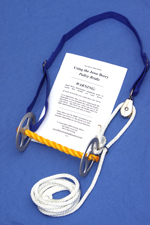Does Your Horse Come With A Warning Label?
Trainer Andy Curry is discussing warning labels and horses:
Wouldn’t it be neat if horses came
with warning labels?
After all, things us consumers buy
always have warning labels.
Some warning labels are downright
outrageous.
For instance, on a bottle of hair
coloring there was a warning that said:
“Do not use as an
ice cream topping.”
No,…I’m not joking.
Here’s one that’ll cause you to
puzzle.
It was a warning from a laser pointer.
It said:
“Do not look into
laser with remaining eye.”
Remaining eye????!!
But again, wouldn’t it be neat if
horses came with warning labels?
If they did, would it reduce the
number of accidents?
After all, if you’re getting a horse
that’s been ridden or trained by someone else,
you don’t know what you’re getting – unless
you know who trained and rode.
The only other way I know of is to
evaluate the horse.
But to evaluate, you really need to
know what to look for.
In Doug and Danie Hewlett’s Reining
DVD set, they show some good evaluation techniques.
Sure they’re doing it from a Reining
standpoint, but it just so happens that
it is pertinent to horses no matter the discipline.
For example, how would you like to
know if your horse is in agreement with you?
In other words, if you ask your horse
to do something…does he do it willingly
or is he not happy about it.
If he does it willingly then that is
certainly a good sign.
You have just evaluated that his mind-
set is that of willingness. Another quick
test or two would be advised to confirm it.
That’s good.
But if he’s not happy about doing some- thing
you ask of him, then that’s a sign that he may
do what HE wants and he doesn’t care about
what you want.
When you’re on his back, that’s NOT
what you want.
One way to tell if your horse is
willing or not is to ask him to lope in
either the round pen or while lungeing.
When he lopes he may do it freely
or…he may want to kick at you.
If he kicks at you then you know he’s
not in real agreement with what you want.
Would you want to get on a horse that’s
not in agreement with you?
No!
If you’re an experienced rider and trainer you may.
But you may not either.
I know trainers who refuse to get on
other people’s horses because they don’t
know the horse.
Does that mean they’re not worth their
salt?
No.
It means they’re thinking about their
safety and they’ve been hurt enough times that
they aren’t going to risk injury un-necessarily.
Thus, it’d be neat if horses came with
warning labels.
But since they don’t, you should really know
some evaluation techniques.
Doug and Danie Hewlett show some
valuable evaluation techniques in their Reining DVD.
If you feel you need to bone up on your safety by
knowing more about evaluating horses, just click
the following to know more:
Get Your Hewlett Reining DVD
Oh.
Here’s one more warning label I thought
you’d get a kick out of.
Once you read it, you’ll know exactly
why it was put on the product.
On a Batman costume the warning label said:
“Warning: Cape does not
enable user to fly.”


